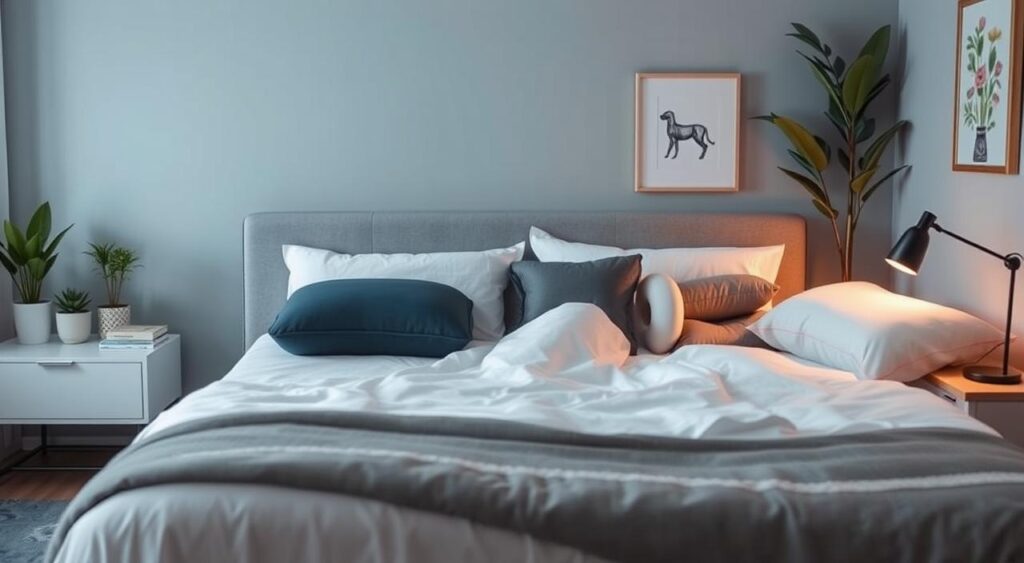Did you know nearly one-third of Americans don’t get enough sleep? This lack of quality rest often ties back to healthy sleeping positions. The way we sleep greatly affects our health and well-being. By adopting proper sleep alignment, we can greatly improve our sleep quality and feel more comfortable at night.
In this article, we’ll dive into the best healthy sleeping positions. We’ll see how the correct sleep posture can boost not just our sleep but also our long-term health. From side sleeping to back sleeping, knowing these ideal sleeping positions helps us make better choices for a good night’s sleep.
Key Takeaways
- Nearly one-third of Americans struggle with sleep quality.
- Healthy sleeping positions are vital for overall well-being.
- Correct sleep posture can reduce discomfort and pain.
- Proper sleep alignment improves sleep quality significantly.
- Understanding different sleeping positions is essential for better rest.
Understanding the Importance of Sleep Posture
The role of sleep posture is huge. Getting the body in the right position is key for a good night’s sleep. Bad sleep positions can cause pain, disrupt sleep, and lead to health problems. This can make everyday tasks harder.
Good sleep habits mean paying attention to how you sleep. The right position supports your spine and boosts your health. It shows how important it is to find the best sleeping position.
Watching how you sleep can make a big difference. You’ll wake up feeling better, with more energy. Focusing on sleep posture can lead to better health and a better life.
| Effects of Poor Sleep Posture | Benefits of Correct Sleep Posture |
|---|---|
| Back pain | Improves spinal health |
| Neck strain | Reduces discomfort |
| Sleep disruption | Enhances overall sleep quality |
| Fatigue | Increases energy levels |
Understanding sleep posture lets you control your rest. Changing your sleep habits can greatly improve your comfort and health.
Healthy Sleeping Positions
Choosing the right sleep position can greatly improve your health. The correct posture not only makes you feel more comfortable but also supports your body’s functions. Here are three main positions that are good for your body, their benefits, and things to watch out for.
Side Sleeping
Side sleeping is a favorite among many. It keeps your spine aligned and can help prevent snoring. It’s also great for pregnant women because it boosts blood flow. But, it might cause shoulder pain if you don’t have the right support.
Back Sleeping
Back sleeping is best for keeping your spine straight. It spreads out your body’s weight and can ease joint pressure. Adding a pillow under your knees can make it even more comfortable. Yet, it might make snoring or sleep apnea worse for some people, so it’s important to think about how it affects you.
Stomach Sleeping
Stomach sleeping is not usually recommended because it can hurt your neck and spine. It might help with snoring, but it often causes discomfort and misalignment. Health experts often suggest avoiding this position unless you can keep your body in the right position to avoid pain.
| Position | Benefits | Drawbacks |
|---|---|---|
| Side Sleeping | Improves spinal alignment, reduces snoring | Possible shoulder pain |
| Back Sleeping | Maintains neutral spine, evenly distributes weight | May worsen snoring or sleep apnea |
| Stomach Sleeping | Can reduce snoring | Strains neck and spine |
Knowing about these positions helps you make better choices for your sleep. This can lead to healthier sleep and better rest.
Benefits of Proper Sleep Alignment
Getting the right sleep alignment is key to feeling your best. It helps keep your body in line, which is good for your spine. This alignment is important for keeping your spine’s natural shape, making you feel better when you’re awake.
Improved Spinal Health
Proper sleep alignment lets your spine rest right, easing the strain on your back and neck. This is great for your spine’s health, helping it heal and refresh while you sleep. When your spine is aligned right, you’re less likely to get long-term health problems.
Reduction in Aches and Pains
Bad sleeping can cause pain. But, proper sleep alignment can help a lot. It eases tension in important areas, making your sleep better and your day more comfortable.
| Aspect | Effect of Proper Alignment |
|---|---|
| Spinal Curvature | Maintains natural curvature, reducing strain |
| Muscle Tension | Decreases muscle tension and discomfort |
| Chronic Conditions | Minimizes risk of chronic pain conditions |
| Sleep Quality | Enhances overall sleep quality and comfort |
Correct Sleep Posture for Different Body Types
Every body type has its own sleep needs. It’s important to find the right sleep posture for each one. People with heavier bodies might need special positions to support their weight. Those who are lighter might find relief in different ways.
Choosing the right sleep position is key. Side sleeping is great for those with broad shoulders, as it keeps the spine aligned. Back sleepers can use knee elevation to support their lower back. But stomach sleeping can be tough for many, as it strains the neck and spine.
Health conditions also play a role in choosing the right sleep posture. For example, left-side sleeping can help with acid reflux. It’s also good for those with sleep apnea, as it keeps the airways open.
Adjusting your sleep position can greatly improve your comfort and health. Finding the right balance between comfort and health is crucial. It helps you sleep better every night.
Optimal Sleep Posture for Pregnant Women
Pregnant women face unique sleep challenges. Finding the right sleep posture is key for both mom and baby’s health. Studies show that side sleeping, especially on the left, is best. It helps blood flow and reduces pressure on important organs.

Recommended Positions
Choosing the right sleep position is crucial for a good night’s sleep. Here are some top picks for pregnant women:
- Left Side Sleeping – This position boosts blood flow to the baby and eases liver pressure.
- Right Side Sleeping – Though not as good as the left, it can still be comfy and prevent back pain.
- Using a Pillow Between the Knees – A pillow here can keep hips aligned and offer extra support.
- Pillows to Support the Abdomen – Extra pillows can make the belly feel supported and ease back strain.
By sticking to these sleep postures, pregnant women can sleep better. This is vital for their health and their baby’s.
| Sleep Position | Benefits | Considerations |
|---|---|---|
| Left Side | Boosts blood flow, reduces pressure on organs | May require adjustment with body pillows |
| Right Side | Comfortable, alleviates back pain | Not as beneficial as left side |
| Using Pillows | Supports body alignment, enhances comfort | Pillows must be adjusted as pregnancy progresses |
Ideal Sleeping Positions for Snorers
Finding the right sleep posture can greatly affect snoring. Certain sleeping positions help improve airflow and reduce nighttime disturbances. Knowing these ideal sleeping positions can help find effective snoring solutions.

How Sleep Position Affects Snoring
When looking at sleeping positions for better health, it’s key to see how they impact snoring. Some important points include:
- Sleeping on the back can cause the tongue and soft palate to collapse to the back of the throat, leading to increased snoring.
- Side sleeping often promotes better open airways and may significantly reduce snoring tendencies.
- Elevating the head with pillows can also help improve airflow and minimize snoring.
Choosing practical methods to adjust sleep posture will enhance sleep quality. Testing various ideal sleeping positions may lead to discovering the most effective approach for minimizing snoring. Understanding how sleep position can play a role in respiratory function ultimately contributes to achieving restorative sleep.
| Sleeping Position | Effect on Snoring |
|---|---|
| On Back | Increases likelihood of snoring |
| On Side | Reduces snoring frequency |
| Head Elevated | Improves airflow, decreases snoring |
Incorporating this knowledge of sleeping positions for better health can help individuals develop a more restful night’s sleep, minimizing disturbances caused by snoring.
Comfortable Sleep Positions for the Elderly
As people get older, sleep can be hard to find. Health issues and less mobility play a big role. Finding the right sleep positions can really help improve sleep quality. Here are some tips for comfortable sleep positions that help avoid discomfort.
For seniors, the right sleep posture is key to a good night’s sleep. Some good sleep positions include:
- Side Sleeping with a Pillow: A pillow between the knees can keep hips aligned and lower back strain down.
- Back Sleeping with Leg Support: Elevating legs with a pillow or wedge can ease spine pressure and boost blood flow.
- Reclining Position: Using a recliner or adjustable bed can offer support and reduce pressure points, making sleep more comfortable.
It’s also important to think about other sleep solutions for the elderly to boost comfort:
- Choosing a mattress that’s supportive but not too hard can make a big difference.
- Memory foam or gel-infused pillows can mold to the head and neck, offering comfort and relieving pressure.
- Keeping the sleeping area quiet and at a comfortable temperature can also help improve sleep quality.
By using these ideal sleep positions and supportive bedding, sleep quality for the elderly can greatly improve. Making sleep comfortable is key to better health and happiness in later years.
| Sleep Position | Benefits |
|---|---|
| Side Sleeping | Reduces pressure on joints; helps with snoring |
| Back Sleeping | Promotes spinal alignment; eases chronic pain |
| Reclining Position | Ideal for those with respiratory issues; reduces acid reflux |
Sleeping Positions for Better Health
Choosing the right sleeping position can greatly improve your health. Knowing the benefits of sleep positions helps you make better choices. Some positions are better for your digestive and heart health.
Impact on Digestive Health
Sleeping on your left side is good for your digestion. It helps food move better through your digestive system. This can help with acid reflux and improve your gut health.
Effects on Heart Health
Some sleeping positions can affect your heart. Sleeping on your left side may lower heart pressure and improve blood flow. This is good for people with heart issues. Knowing this can help you sleep better for your heart.
| Sleeping Position | Digestive Health Benefits | Heart Health Benefits |
|---|---|---|
| Left Side | Enhances digestion, reduces acid reflux | Reduces pressure on the heart, improves circulation |
| Right Side | Moderate digestion improvement | May put some pressure on the heart |
| Back | Neutral, can lead to issues with acid reflux | Maintains spinal alignment, but may worsen sleep apnea |
| Stomach | Can cause strain on the digestive organs | May cause neck and back issues affecting overall heart function |
Being aware of these positions can help you choose better for your health. Adopting the healthiest positions can make your sleep more restful and beneficial.
Common Mistakes in Sleeping Positions
It’s important to know the common mistakes in sleeping positions to improve sleep quality. Many people unknowingly sleep in ways that cause discomfort and poor rest. Sleeping on the stomach is a common mistake. It can force the neck into awkward angles, leading to tension and pain.
Using the wrong bedding can also lead to unhealthy sleeping habits. Pillows that don’t support the head and neck properly can worsen alignment issues. A mattress that’s not firm enough can also cause discomfort, making it hard to sleep well.
Sleeping in cramped or contorted positions is another common issue. These positions can create pressure points that disrupt sleep. Knowing these mistakes helps people change their habits for better sleep. Fixing these mistakes can lead to a more restful night’s sleep.
Pillows and Their Role in Sleep Posture
Pillows play a big role in keeping your body aligned while you sleep. The right pillow can make a big difference in how well you sleep. Knowing about different types of pillows can help you find the best one for you.
Choosing the Right Pillow for Side Sleepers
Side sleepers need a pillow that keeps their spine straight and feels comfy. The pillow should fill the space between your head and shoulders. This keeps your neck from bending too much.
Look for pillows that are medium to firm. They offer the right amount of support. Also, a pillow with a higher loft is better. It helps keep your head in line with your spine.
Memory foam and latex pillows are great for side sleepers. They mold to your head and neck, making you feel supported and comfortable.
Pillow Options for Back Sleepers
Back sleepers need pillows that support their neck’s natural curve. They should not lift the head too high. Here are some good options:
- Moderate Firmness: Medium firm pillows help keep your spine aligned while being comfy.
- Thin Design: Thin pillows help keep your head in line with your spine, avoiding neck strain.
- Contoured Shapes: Ergonomic pillows offer special support for your cervical spine.
How to Transition to a Healthy Sleep Position
Switching to a healthy sleep position can greatly improve your well-being. It might take some time, but with the right approach, you can sleep better. Here are some tips for side and back sleepers.
Tips for Side Sleepers
Side sleepers can make small changes to sleep better:
- Use a supportive pillow to keep your neck aligned, which is key for side sleepers.
- Put a pillow between your knees to ease hip and spine pressure.
- Avoid curling up too much, as it can cause discomfort and strain.
- Try different mattresses to find one that supports and comforts you right.
Adapting Back Sleeping Techniques
Switching to back sleeping can help your spine. Here’s how:
- Start by changing your sleep position for short times each night.
- Use a firm pillow to support your neck’s natural curve, helping your sleep posture.
- Place a small pillow under your knees to ease lower back pressure.
- Practice relaxation before bed to help your body get used to the new position.
By adding these tips to your bedtime routine, you can easily switch to healthier sleep positions. This will improve your sleep quality.
Using Sleep Aids for Improved Posture
Various sleep aids help improve sleep quality and keep the body aligned. Using sleep aids for better posture can greatly enhance restfulness and health. Body pillows and mattress toppers are two great options for maintaining spinal alignment while sleeping.

Body pillows support side sleepers, keeping the body in a natural position. This helps maintain spinal alignment and lowers discomfort risk. Back sleepers need the right pillow and mattress. A supportive mattress topper adds the needed firmness or softness for comfort.
Adding these aids to healthy sleeping routines creates a great sleep environment. When picking sleep aids, think about your body type and comfort needs. Using these tools well helps build habits that support better posture and overall well-being during sleep.
Adjusting Your Mattress for Better Sleep Posture
Finding the right mattress can make a big difference in sleep posture. When looking at mattress adjustment, firmness and support systems are key. A mattress that fits your needs can lead to better sleep.
Different body types and sleep positions need different support levels. For example, side sleepers might prefer a softer mattress to cushion their shoulders and hips. Back sleepers usually need medium support to keep their spine aligned. Knowing these details helps find the best mattress type.
- Memory Foam: Molds to the body, providing excellent support for various sleep positions.
- Latex: Offers a responsive surface that retains shape, suitable for those who shift positions at night.
- Hybrid: Combines innerspring coils with foam layers for a balance of support and comfort.
Choosing the right mattress is a key part of healthy sleep solutions. The right firmness and comfort can help improve posture and overall well-being.
| Sleep Position | Recommended Mattress Type | Benefits |
|---|---|---|
| Side Sleepers | Soft to Medium Firm | Relieves pressure on shoulders and hips |
| Back Sleepers | Medium Firm | Supports spinal alignment |
| Stomach Sleepers | Firm | Prevents sinking and promotes proper alignment |
Maintaining Optimal Sleep Environment
Creating a great sleep environment is key to better sleep. Room temperature, lighting, and noise levels are important. A cool room, between 60 to 67 degrees Fahrenheit, is best for comfort.
Lighting affects sleep too. It’s good to keep the bedroom dark to avoid light disrupting sleep. Blackout curtains or sleep masks help a lot. Also, reducing noise with soundproofing or white noise machines makes sleep better.
Here’s what you need for a good sleep environment:
- Maintain a cool room temperature
- Keep the bedroom dark using curtains or masks
- Minimize noise with soundproofing or white noise
Natural Remedies for Better Sleep Quality
Natural sleep remedies are becoming popular for their ability to improve sleep. Many people are looking for alternatives to traditional sleep aids. Herbal teas like chamomile and valerian root are favorites because they help calm the mind and body.
Meditation and yoga are also great for sleep. They help lower stress and make the body and mind relax. Adding these to your bedtime routine can help you sleep better.
Aromatherapy is another effective remedy. Essential oils like lavender or jasmine create a peaceful atmosphere. Using these oils in your evening routine can improve your sleep quality.
The table below outlines various natural remedies, their applications, and benefits for improving sleep quality:
| Natural Remedy | Application | Benefits |
|---|---|---|
| Herbal Tea | Drink before bedtime | Promotes relaxation and reduces insomnia |
| Meditation | Practice 10-15 minutes daily | Reduces stress, enhances mental clarity |
| Yoga | Incorporate gentle stretches at night | Alleviates tension, improves flexibility |
| Aromatherapy | Use essential oils in a diffuser | Creates a calming environment, helps mind unwind |
Adding these natural sleep remedies to your bedtime routine can greatly improve your sleep. They are part of a holistic approach to better rest. With a bit of effort, you can enjoy restful nights every night.
Conclusion
This article has shown how important it is to sleep in the right position for our health. By choosing the right sleep posture, we can sleep better. This not only makes us feel more comfortable but also helps with pain, keeps our spine healthy, and boosts our digestion and heart health.
Thinking about the tips on sleep from this article, we see that changing how we sleep can really help. Small steps like sleeping on our side, picking the right pillows, or creating a good sleep space can make a big difference. It’s key to sleep in a way that keeps our body aligned for a better life.
We should all try to make these changes to improve our sleep. By doing so, we can live more fully and energetically. Remember, sleep is a big part of staying healthy and feeling good.
FAQs
What is the best sleep position for pregnant women?
Side sleeping, especially on the left side, is recommended for pregnant women as it boosts blood flow to the baby and reduces pressure on vital organs.
How can sleep position reduce snoring?
Sleeping on your side or elevating your head can help keep airways open, reducing the likelihood of snoring by improving airflow.
What are comfortable sleep positions for the elderly?
Side sleeping with a pillow between the knees, back sleeping with leg support, and reclining positions using adjustable beds are ideal for the elderly to enhance comfort and reduce pain.
How do sleep positions impact digestive health?
Sleeping on the left side aids digestion by promoting better food movement through the digestive system, which can help alleviate acid reflux and improve gut health.
When should I consider using sleep aids for better posture?
If you experience discomfort or difficulty maintaining a healthy sleep position, using sleep aids like body pillows or mattress toppers can help improve alignment and enhance sleep quality.








